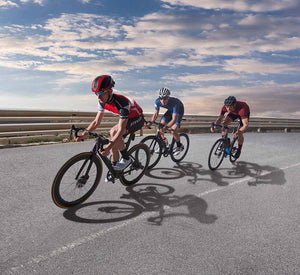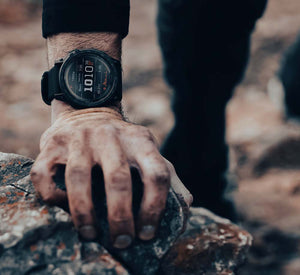
Detailed Review: Why Arccos Smart Sensors + Link Pro Are My Favorite Way to Play Golf
And Why It Might Not Be Right for You.
Are you ready to learn everything about your golf game? Our golf reviewer Marc explains exactly what it's like using the Arccos Shot-Tracking System!
Knowledge is power, as they say.
That may be especially true about golf, where the more we know about our games, our swings, our capabilities, and our limitations, the better chance we have at improving.
But knowledge can also be sobering, humbling, and even humiliating.
And that is for damn sure true about golf, where the more we learn about just how far removed we are from the golfer we want to be, the more depressing this golf life can become.
Arccos taught me all of this. Using it is like having a mirror pointed at your golf soul. The Arccos Smart Sensors combined with the new Link Pro transistor/receiver is so incredibly insightful, accurate, and consistent that I have never played with a shot-tracking system so revealing and reliable.
It tells you everything you could possibly want to know about your golf game. And a lot that you didn’t want to know. There’s no hiding anything.
And the truth can be terrifying.
So here’s the question in deciding whether Arccos is right for you: Can you stand a golf intervention?
Arccos Smart Sensors and Link Pro: How Does It All Work?
The Arccos system works by using a combination of sensors and a smartphone app to automatically track and analyze your golf shots.
As the system has evolved, it’s become increasingly accurate and easier to use. To the point that now, with the Arccos Smart Sensors and new-in-2024 Link Pro device, the system is pretty much flawless.
The Smart Sensors attach to the butt end of your golf clubs and then automatically transmit information about your shots to the Link Pro, a tiny device you keep in your pocket, which acts as the bridge between the sensors and your phone app, allowing you to simply play golf while all of the information about every shot you hit is automatically recorded and analyzed.
Here’s a simple breakdown of how it works:
- Smart Sensor Installation. You screw small sensors to the end of each club’s grip. There’s one sensor per club, including the putter.
- Pairing. You pair the sensors with the Arccos app on your smartphone. This is done once, the first time you set up the system. Additionally, you pair the Link Pro with both the sensors and app.
- Playing. As you play golf, each sensor automatically detects when and where you hit a shot. The system uses your phone’s GPS to determine the location of each shot on the course. When you’re playing without a Link Pro or the previous generation Link, you need to keep your phone in your pocket while you play. The Link Pro allows you to go phone-free.
- Data Syncing and Analysis. The data from each shot is transmitted to your smartphone and analyzed by the Arccos app. The app provides insights such as distances hit with each club, shot patterns, and so much more.
- Real-Time Feedback. During your round, you can view stats and analytics on your smartphone or a connected smartwatch. The system can also offer real-time strategy advice, like club selection and shot direction, based on your past performance and current weather conditions and elevation.
- Post-Round Review. After your round, you can review all your shots and statistics. The app provides detailed analytics, including “Strokes Gained” to help you understand your strengths and weaknesses.
Arccos sells a pack of 14 Smart Sensors for $199.99. Or you can get 14 grips with built-in sensors for $249.99. But unless you’re using an additional device like their Link Pro, you’ll need to play with your phone in your pocket to track all of your shot information. And that’s a big buzzkill for a lot of players, including me.
Which is why I think the Link Pro is so awesome. You can slide this little device, smaller than most key fobs, into your pocket and then leave your phone in your bag. The Link Pro seamlessly communicates with both the sensors and the app all without you noticing anything.
Before 2024, Arccos had a couple of generations of their Link device, but the best solution they had come up with before now required you to wear the device on your belt. For a lot of us, that’s a little too “fanny pack” or “cell-phone-in-a-belt-holder” for our golf style sensibilities.
The Link Pro, which retails for $224.99, solves that issue. And it includes a much more robust battery life and even better shot-tracking accuracy. For most golfers already in the Arccos ecosystem, the Link Pro is a game changer. And for most people new to the system, I think it’s the definite way to go.
An Incredible Array of Information, but Be Careful What You Ask For
I like to think of myself as a golf optimist. I think a lot of us are like this. We play poorly, maybe even in the majority of our rounds, but somehow, we always think tomorrow will be better.
But Arccos can humble you in a way that only using it can really explain. Without the right mindset and commitment to working on your game, it can turn you from a golf optimist and skip right past golf realist to full-blown golf pessimist.
Did you know that I pull 58 percent of my drives left? Of course you didn’t. And neither did I.
But I do now, and the information is… well, sobering.
On the bright side, I’m hitting the ball inside of 15 feet out of greenside bunkers.
Of course, that’s not great when I’m making 3.4 fewer one-putts than my target handicap counterpart.
Not to mention that I’m coming up short on 56 percent of my approach shots.
You see the kinds of insights that Arccos gives you? I’m not even scratching the surface.
The information can be both incredibly powerful and an unfortunate reminder of all the varied ways our games are lacking. It’s all stuff we all already know deep down. But if you’re like me, you tend to explain away the poor shots and focus your memories on the fleeting moments of grandeur. Arccos affords you no such luxury. You’re gonna get the cold, hard truth rammed down your throat every time you open the app.
Arccos tracks and then breaks down an unbelievable assortment of information about every one of your shots, every one of your clubs, and every one of your rounds. It organizes the information by club and by shot type, and then presents it in a variety of ways, including tables, graphs, charts, tendencies, trends, and most importantly, Strokes Gained, which we’ll discuss below.
What’s incredibly cool is that you get a full visual recap of every round you play, all overlaid on a satellite image of each hole. Not only is this a useful game-improvement tool, but think about memorable rounds that you play or particularly interesting destinations. How cool to be able to to walk through and relive all of your shots and to even go back and check out that information after your memory has faded.
The downside is that after a free first year, it costs $12.99 per month with an auto annual renewal to access the Arccos system. At a little over $150 a year, that might strike some people as expensive and others as pretty low. I think the value is more than commensurate with the price. But only if you’re going to use the data.
What Are Strokes Gained?
Strokes Gained is the backbone of the Arccos information system. All of these metrics that it’s tracking are distilled down into this simple-to-understand means of comparing your performance to someone else’s.
Strokes Gained is a statistical method used to measure a player’s performance relative to the field. Each shot is compared to a statistical model of how many strokes a standard player would need to finish the hole from that same position.
For example, if a player is 150 yards from the hole in the fairway, the model estimates how many strokes a standard player would need, on average, to get the ball in the hole from there. If the model estimates that a standard player would need 3.5 strokes to hole out, and the player does it in 3 strokes, the player has a Strokes Gained of 0.5 because they took 0.5 fewer strokes than the baseline.
On the PGA Tour, the “standard” is the rest of the field or the rest of the tour members. You’ll see Strokes Gained rankings for various statistical categories, showing how one pro compares to the rest of the field.
But with Arccos, you can customize your Strokes Gained experience. You can set the app to compare you to tour pros or to players of any golf handicap. So if you’re a 20 hoping to improve to a 15, you can set your Arccos profile to show Strokes Gained comparisons between you and a 15 handicap so that you can see with total clarity exactly which parts of your game you’ll have to improve and by how much if you want to reach your handicap goal.
This is unbelievably powerful information if, of course, you’re going to actually use it to work on your game. The Arccos app tracks everything you’re doing, and then gives you Strokes Gained numbers for the most minute details about your performance. You’ll learn how you stack up against your model for things like driving distance and accuracy, shots out of the rough, approach shots from the left, center, or right, approach shots to various pin distances, chip shots inside of 25 yards or pitch shots between 25 and 50 yards, putts of various distances, and on and on.
You’ll see Strokes Gained numbers for all of the various shot categories and for every club in your bag. And you’ll get total numbers showing how your overall Strokes Gained compares to your standard over an 18-hole round.
It’s wild how detailed it gets and from how many different angles it analyzes your golf game. And the Arccos app displays the information in a way that’s really intuitive and simple to navigate.
On the Golf Course With Arccos Link Pro
Let me take a second to describe my first impressions of the Arccos Smart Sensors and Link Pro. The packaging and presentation for each of these companion products is totally first-rate. Beautiful even. Everything is presented in a very minimalistic, super clean way that just exudes class.
Each product comes with a small instruction manual that organizes the information in a visual-heavy, sequential, step-by-step manner. Really easy to follow and get started.
The very first time you use the Smart Sensors and Link Pro, I’d allow for at least an hour. It takes a few minutes to screw in the sensors and then a couple more to pair each club with the app. And I’d advise reading the instructions for a change and checking out all of the various tips and tutorials. There’s a lot of useful information that will make using the Arccos system more beneficial to you. This is one of those products that you want to learn well to make sure that you’re using it to your greatest advantage.
Once you’re out on the course, the Arccos system is so unbelievably easy to use, it’s crazy. I’m talking about showing up at the course, turning on the Link Pro, launching the app, starting a round, putting the Link Pro in your pocket, and you’re done. The whole thing takes a matter of seconds.
The beauty of the Link Pro is that it allows you to play without being tethered to your phone. While you’re playing your normal round, the Smart Sensors, Link Pro, and app are all working to collect your data and have it available for your later review. The only manual thing you need to do is click a small button on the Link Pro each time you arrive at the hole location. This allows the system to pinpoint that exact pin location so that all of the shot data is accurate down to the specific yard. If you skip this step, no big deal. Your distances may be off by a yard or two but that’s probably inconsequential if that only happens every handful of holes.
I know a lot of people will love having the ability to collect all of that data without having to do anything while they’re playing.
But I actually like keeping the app open while I’m playing. That’s because it’s got an incredible amount of awesome strategic information available. It’s like having a rangefinder and top-end golf watch rolled into one. You get front-middle-back GPS distances to every pin, and you also get a front-middle-back Arccos Caddie number that takes into account slope, wind, and weather.
And the app will recommend what club you should hit based on all of those factors plus how your data suggests you’re likely to hit each different club. So you’re getting club recommendations specific to your individual game. It’s not recommendations based on how you think or hope you hit each club, it’s based on how you actually do hit each of those clubs.
To me, having that kind of information on the course is too good to pass up. I don’t like playing with my phone in my pocket, and I love the Link Pro for that reason. But I do keep my phone either in my bag or cart for easy access when I want to get these really powerful insights.
I’ve done it both ways, playing without looking at my phone at all, and playing while checking out the app when I think there’s something useful to learn. For me, I prefer having that information available to me.
As for the Smart Sensors, having them on my clubs has been no issue at all. I don’t notice them. The weight is imperceptible and I’ve yet to have a sensor cause me any issue by hitting my arm or wrist.
The coolest thing about Arccos on the golf course is that you can make it whatever you want. If you want to geek out on all of your information as you’re playing, go for it. If you want to check in for occasional yardages and club recommendations, cool. Or, if you just want to play golf and not be bothered with any technology, you can do that, all while you’re still getting the benefit of that technology.
Post-Round Arccos Editing
In my experience, the only times you’ll really need to edit are when you have penalty shots to add or you’ve taken multiple shots from within a couple of feet of one another. Otherwise, the Smart Sensors/Link Pro combo is crazy accurate.
The Smart Sensors will not record two consecutive shots from within five feet of each other. This is an awesome feature because it allows for things like mulligans or accidentally chunking the ground on a practice swing. Instead, the Arccos system will only read the last shot from a given area.
But that also means that if you hit a ball out of bounds and need to re-tee, the system is only going to pick up that next tee shot. You’ll need to enter your penalty stroke manually.
The same thing goes for if you whiffed the ball or had some other meltdown. I’ve had a couple of flubbed chips that barely moved where I had to manually enter in the chip shot that Arccos didn’t pick up.
When you do need to edit, it’s really easy. I like to do it as soon after a round as possible to try to be accurate. Not because I like the punishment of having to add the strokes but because I’d like my data to be as truthfully accurate as it can be so that it can best serve my game. It’s also fun to review a round visually on the bird’s eye view of the hole to remember what went right and wrong.
Reasons Why You Might Not Need the Arccos Link Pro
I’m a huge fan of the Link Pro. But I’m a bigger fan of the overall Arccos system. So while I’m a big proponent of getting Arccos, you may not need the Link Pro.
If you’re someone who doesn’t mind or is already playing golf with your phone in your pocket, then you don’t need the Link Pro. Just get the sensors. However, if you’re accustomed to playing music using your phone, you won’t be able to play music and use Arccos at the same time. For that, you’d need a Link Pro.
If you’re already using an Arccos Link, the Link Pro is an undeniable upgrade. For one thing, you don’t have to wear the thing on your belt. But superior tracking and battery life (up to 12 rounds of battery life with the new Link Pro) are the biggest pluses.
Depending on your smart watch, you may be able to interface with the Arccos Smart Sensors and get all of your data on your wrist, negating the need for a Link Pro.
And, of course, if you (like Jack Nicholson so famously yelled in the 1992 classic A Few Good Men) can’t handle the truth, then the Arccos system isn’t for you.
Final Arccos Smart Sensors and Link Pro Thoughts
Arccos makes you rip the Band Aid off and face the music. It exposes in so much granular detail everything you’re doing wrong.
But, of course, it also reports the good news when there’s something worth sharing. And it sometimes shows you that your numbers compared to whatever you’re trying to become aren’t as bad in a particular area as you may have feared.
Really, what Arccos does if you use it regularly and pay attention to the information it’s collecting, is make you better. Five strokes better for new members on average, according to Arccos and their data. You have the opportunity to improve your weaknesses and shore up your strengths. To get that information objectively, rather than emotionally is, for me, really useful.
But do you really want to know the hard truth? Are you really going to use the information to work harder and smarter, or is it just going to bum you out?
That, to me, is the biggest thing to sort out before deciding whether or not to buy. After that, if you’re in, then jump in all the way, including with the Link Pro if you’re not in one of the situations where it’s not a smart buy. I think Arccos is going to help you play better golf.
About PlayBetter Golf Reviewer Marc Sheforgen
Marc "Shef" Sheforgen is a golf writer whose passion for the game far exceeds his ability to play it well. Marc covers all things golf, from product reviews and equipment recommendations to event coverage and tournament analysis. When he's not playing, watching, or writing about golf, he enjoys traveling (often golf-related), youth sports coaching, volunteering, and record collecting.












